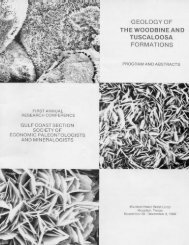Petroleum Systems of Deep-Water Basins - Gulf Coast Section SEPM
Petroleum Systems of Deep-Water Basins - Gulf Coast Section SEPM
Petroleum Systems of Deep-Water Basins - Gulf Coast Section SEPM
Create successful ePaper yourself
Turn your PDF publications into a flip-book with our unique Google optimized e-Paper software.
Falkland Islands: Past Exploration Strategies<br />
and Remaining Potential in<br />
Under-Explored <strong>Deep</strong>water <strong>Basins</strong><br />
Phil Richards<br />
British Geological Survey<br />
West Mains Road<br />
EH9 3LA Edinburgh<br />
Scotland<br />
United Kingdom<br />
e-mail: pcr@bgs.ac.uk<br />
Abstract<br />
The Falkland Islands are surrounded by four major sedimentary basins (the Falkland Plateau basin to the east, the<br />
South Falkland basin to the south, the Malvinas basin to the west, and the North Falkland basin to the north). The<br />
basins underwent complex rifting from the ?Triassic through Valanginian, during fragmentation <strong>of</strong> Gondwanaland,<br />
before being subjected to Cretaceous thermal sag and Cenozoic uplift coincident with Andean compression and the<br />
development <strong>of</strong> overthrusting along the plate boundary to the south.<br />
Only the North Falkland basin was drilled; six wells were spudded back to back by four operators who formed a<br />
unique alliance in 1998 to undertake all <strong>of</strong> the logistics and support work to facilitate a multi-well drilling campaign.<br />
Drilling took place in water depths between 250 and 460 metres. Five <strong>of</strong> the six wells had oil shows, mostly in postrift<br />
sandstones located immediately above the main source rock interval. Live oil was recovered at the surface from<br />
one <strong>of</strong> the Shell wells; significant levels <strong>of</strong> gas were also recorded in some wells. Although none <strong>of</strong> the wells encountered<br />
commercially viable accumulations, it is possible that up to 60 billion barrels <strong>of</strong> hydrocarbons could have been<br />
expelled in the basin. Post-mortem analyses <strong>of</strong> the petroleum system revealed why the wells were non-commercial<br />
and pointed the way to future commercial success.<br />
As well as the remaining potential <strong>of</strong> the North Falkland basin, the other large, deep water to ultra-deep water<br />
basins around the Islands are under explored and are covered only by reconnaissance seismic data. Oxfordian to<br />
Aptian claystones present in DSDP boreholes indicate a potentially prolific hydrocarbon yield from Type II kerogens.<br />
Modelling suggests that the source rocks are possibly mature for oil generation at about 3,000 metres below seabed,<br />
and numerous play types can be predicted on the basis <strong>of</strong> the existing seismic data and by correlation with analogous<br />
basins.<br />
The paper will highlight the entire basin potential <strong>of</strong> the <strong>of</strong>fshore Falklands region (petroleum systems, sequence<br />
stratigraphy, tectonic evolution, etc.), evaluate the pros and cons <strong>of</strong> the unique exploration sharing strategies adopted<br />
so far, and outline the exploration and production challenges posed by the particularly sensitive environmental concerns<br />
in the region.<br />
6

















